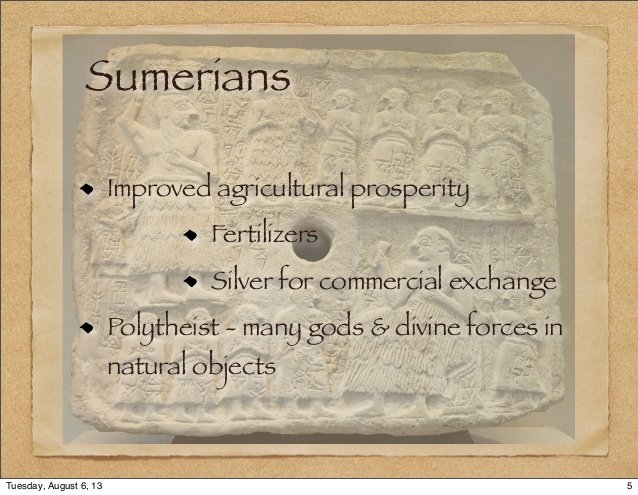
• Mesopotamia
Unit 1 lesson 2 river valley civs
- 1. RIVER VALLEY CIVILIZATIONS UNIT 1 Lesson 2 1Tuesday, August 6, 13
- 2. Tigris-Euphrates 2Tuesday, August 6, 13
- 3. Mesopotamia Civilization ‘from scratch’ Sumerians [most influential] 3Tuesday, August 6, 13
- 4. Sumerians First known writing system [cuneiform] Astronomical sciences Intense religious beliefs tightly organized city-states 4Tuesday, August 6, 13
- 5. Sumerians Improved agricultural prosperity Fertilizers Silver for commercial exchange Polytheist - many gods & divine forces in natural objects 5Tuesday, August 6, 13
- 6. Sumerians Tightly organized city-states ruled by kings w/ divine authority Government regulated religion & provided a court system for justice 6Tuesday, August 6, 13
- 7. Sumerians-->Akkadians-->Babylonians 7Tuesday, August 6, 13
- 8. Hammurabi 8Tuesday, August 6, 13
- 9. Egypt 9Tuesday, August 6, 13
- 10. Egypt Nile river [3000 BC] Trade & Influence from Mesopotamia Durable centralized institutions Mathematics & Architecture 10Tuesday, August 6, 13
- 11. Egypt 2700 onward - Pharaohs directed building of pyramids [tombs] Monumental architecture requiring slave labour 11Tuesday, August 6, 13
- 12. Indus Valley 12Tuesday, August 6, 13
- 13. Indian Civilization Along Indus River by 2500 BC Several large cities [e.g. Harappa] Trade w/ Mesopotamia Distinctive alphabet and art Invasion by Indo-Europeans resulted in almost complete destruction of culture 13Tuesday, August 6, 13
- 14. China 14Tuesday, August 6, 13
- 15. China Developed along the Yellow [Huanghe] River Considerable isolation Organized state regulating irrigation Advanced technology & elaborate intellectual life by 2000 BC 15Tuesday, August 6, 13
- 16. China More continuity b/w Chinese River Valley Civilization and later Chinese civilizations than in other regions Shang Dynasty begins around 1500 BC Impressive tombs and palaces 16Tuesday, August 6, 13
- 17. Heritage of the River Valley Civilizations 17Tuesday, August 6, 13
- 18. River Valley Civilizations the wheel, alphabets, mathematics & divisions of time art & architectural influences Writing systems 18Tuesday, August 6, 13
- 19. The belief that there are fundamental differences between the “civilized” and the “barbarians” is an old and widespread one, used by the Chinese, American Indians, ancient Greeks, and modern western Europeans, to name just a few. The latter attempted to define a series of stages in human development that ranged from utterly primitive to “advanced,” with the advanced culture belonging to the western Europeans. By the 19th century, racial qualities were quantified as qualifiers for position along the hierarchy of “civilization.” In the 20th century much of that intellectual baggage was eventually discarded. At present, the most accepted way to approach a definition of civilization is to see it as one of several ways humans identify social organization 19Tuesday, August 6, 13
- 20. The scope and legacy of the first civilizations are unique to geography and other factors Mesopotamia was flat with few natural barriers to recurrent invasions. Thus the Middle East had an active role as an agent for wider connections with other cultures Egypt, though not isolated, was more self-contained with the Libyan desert, Nile River, and Red Sea serving as barriers. Therefore, Egypt played less of a role as intermediary among different regions China also had less far-reaching contacts than Mesopotamia. But it did make major connections with Japan, Korea, and Vietnam Harappan [Indus Valley] society did trade widely with Mesopotamia; but its rapid decline limited its impact on surrounding cultures. Early Civilizations & The World



